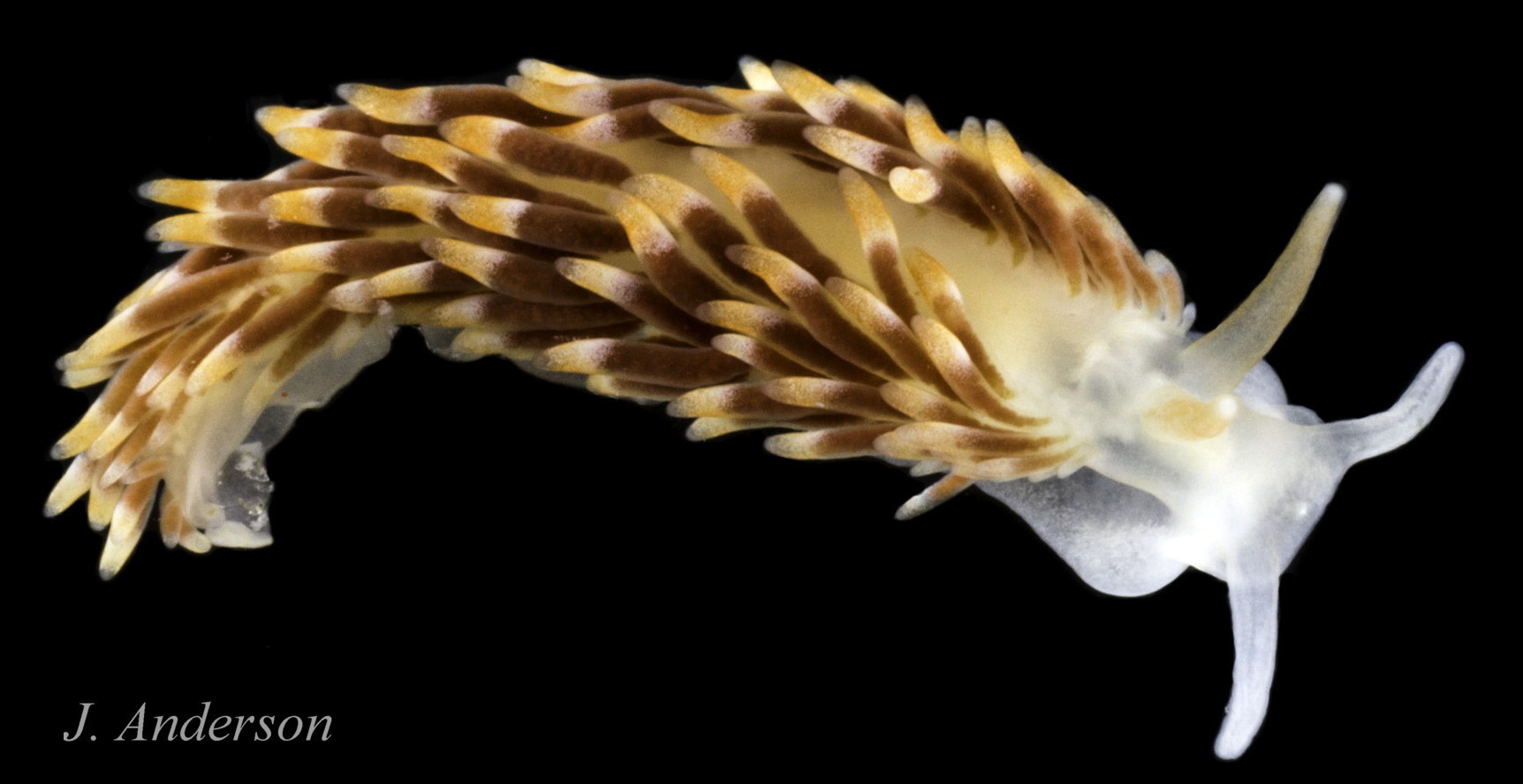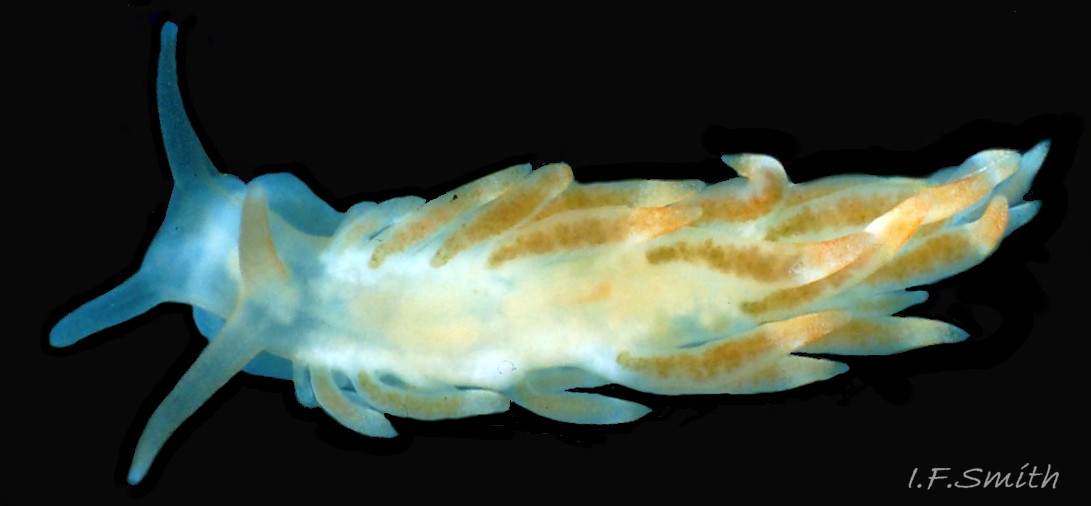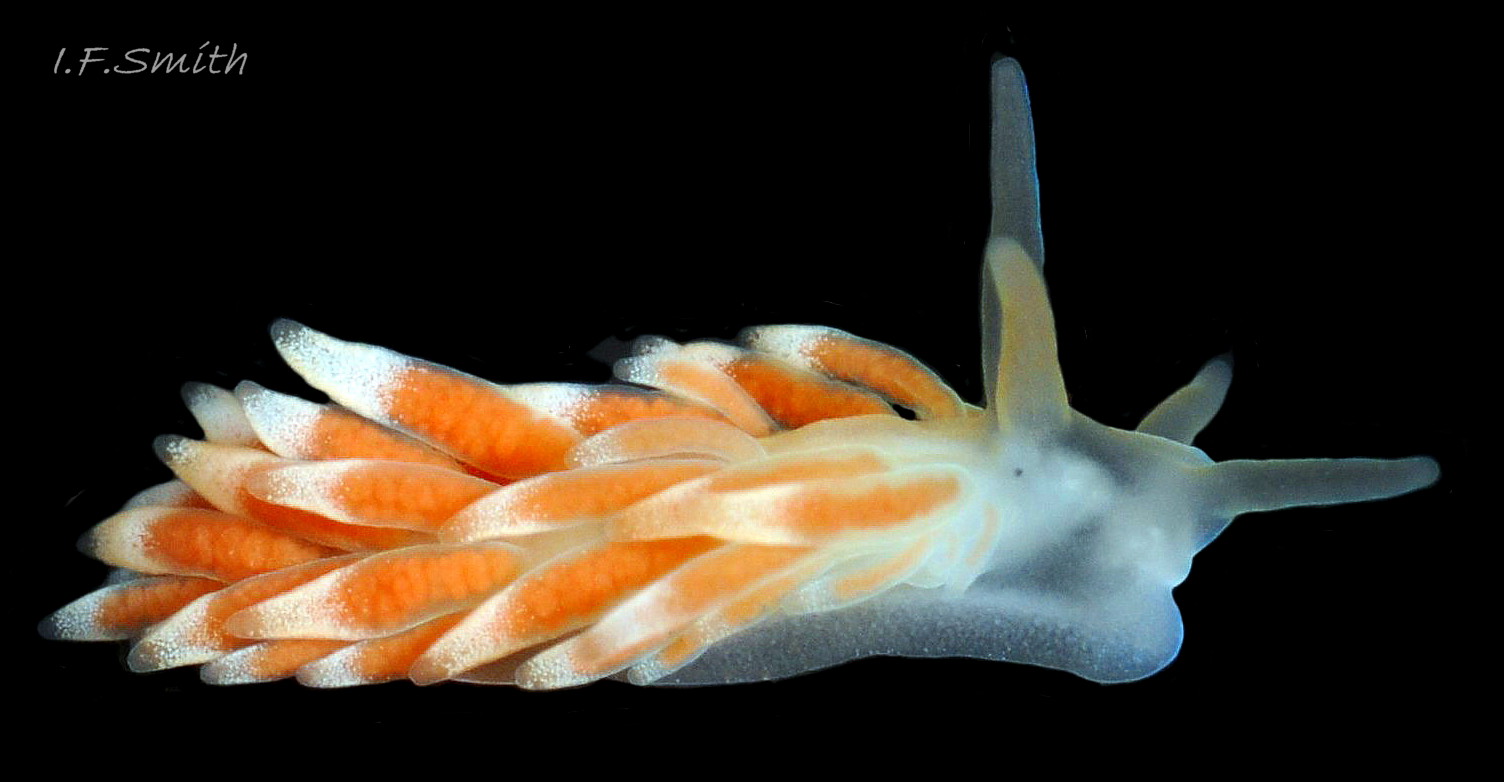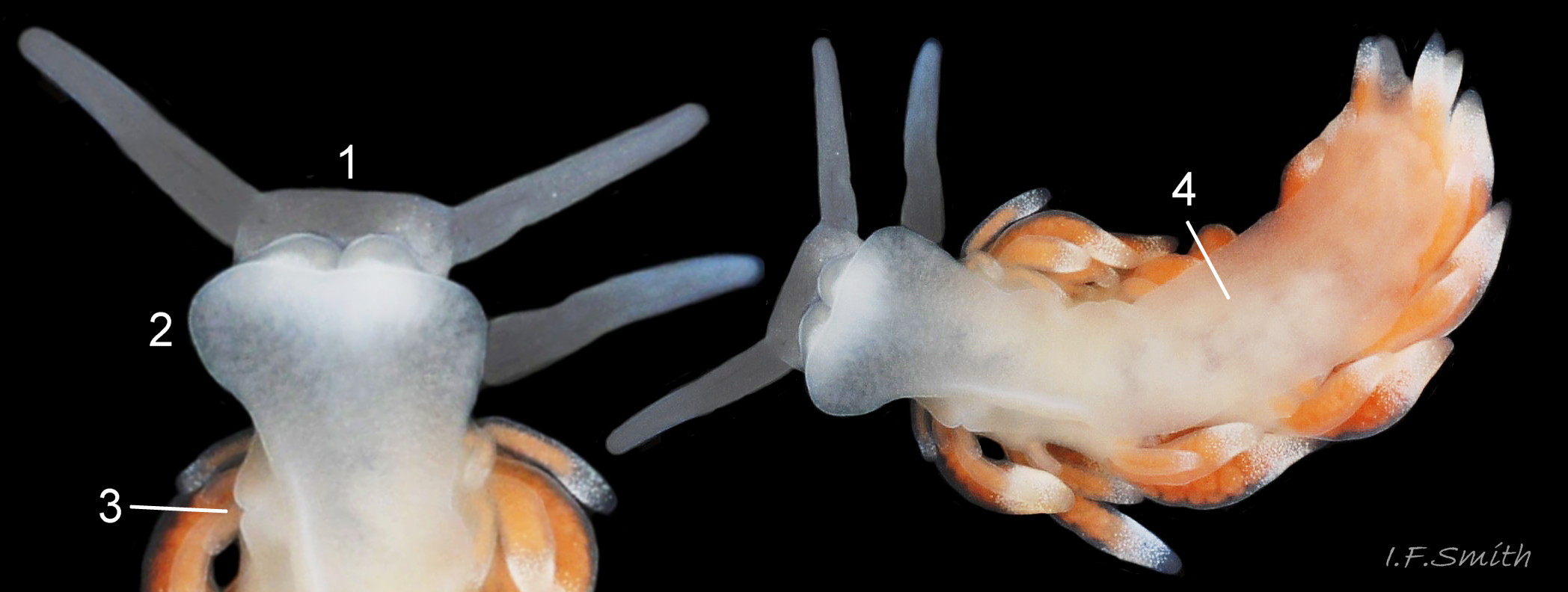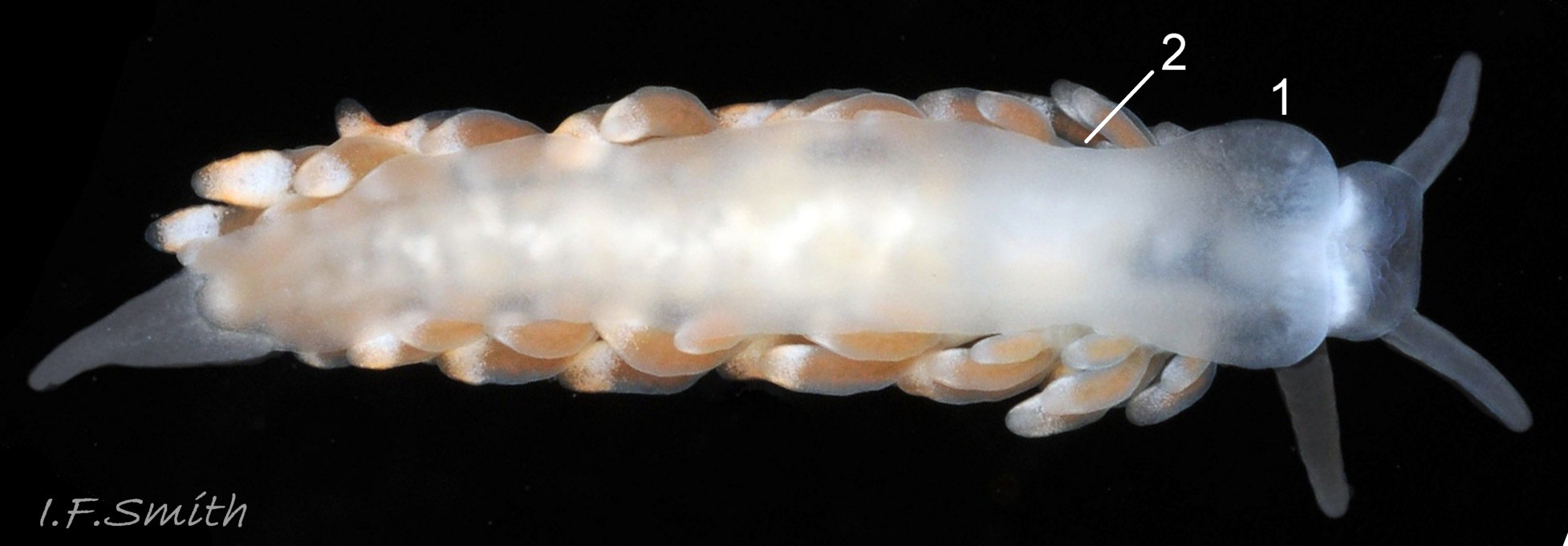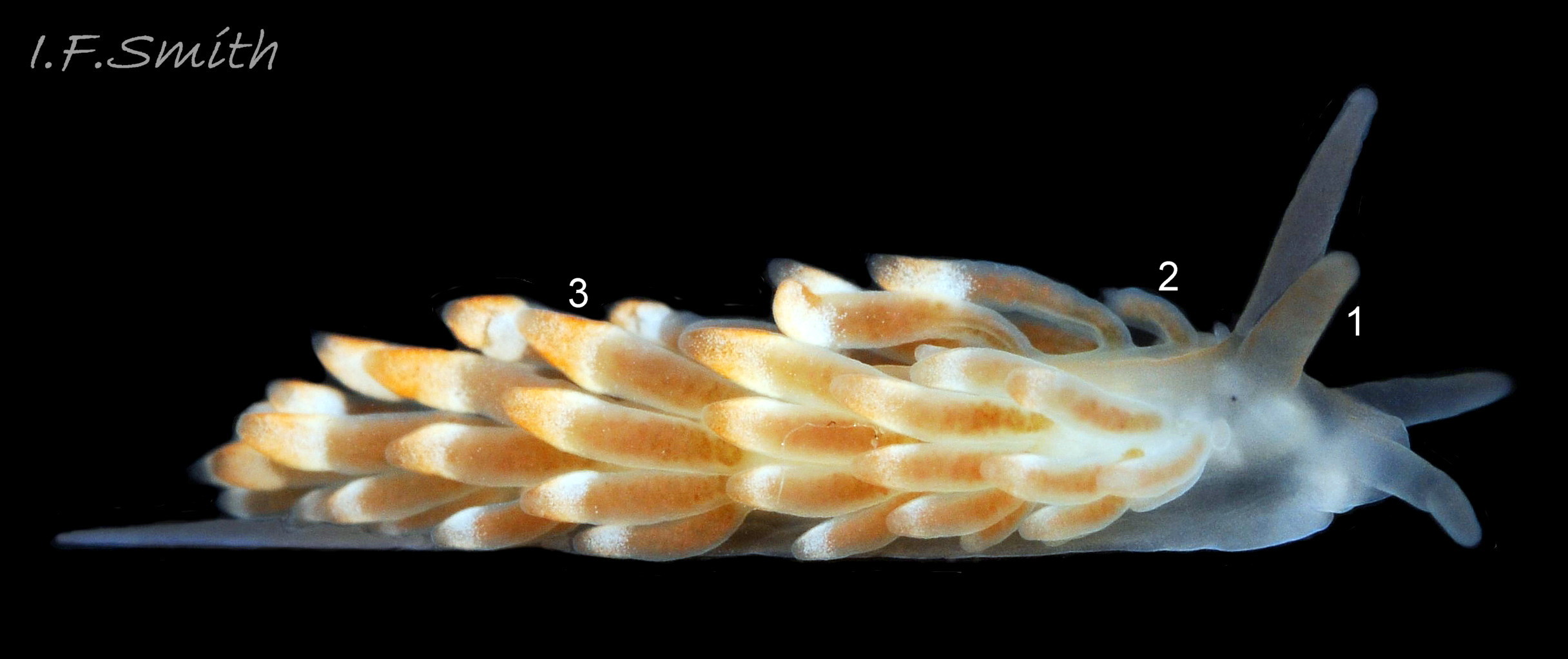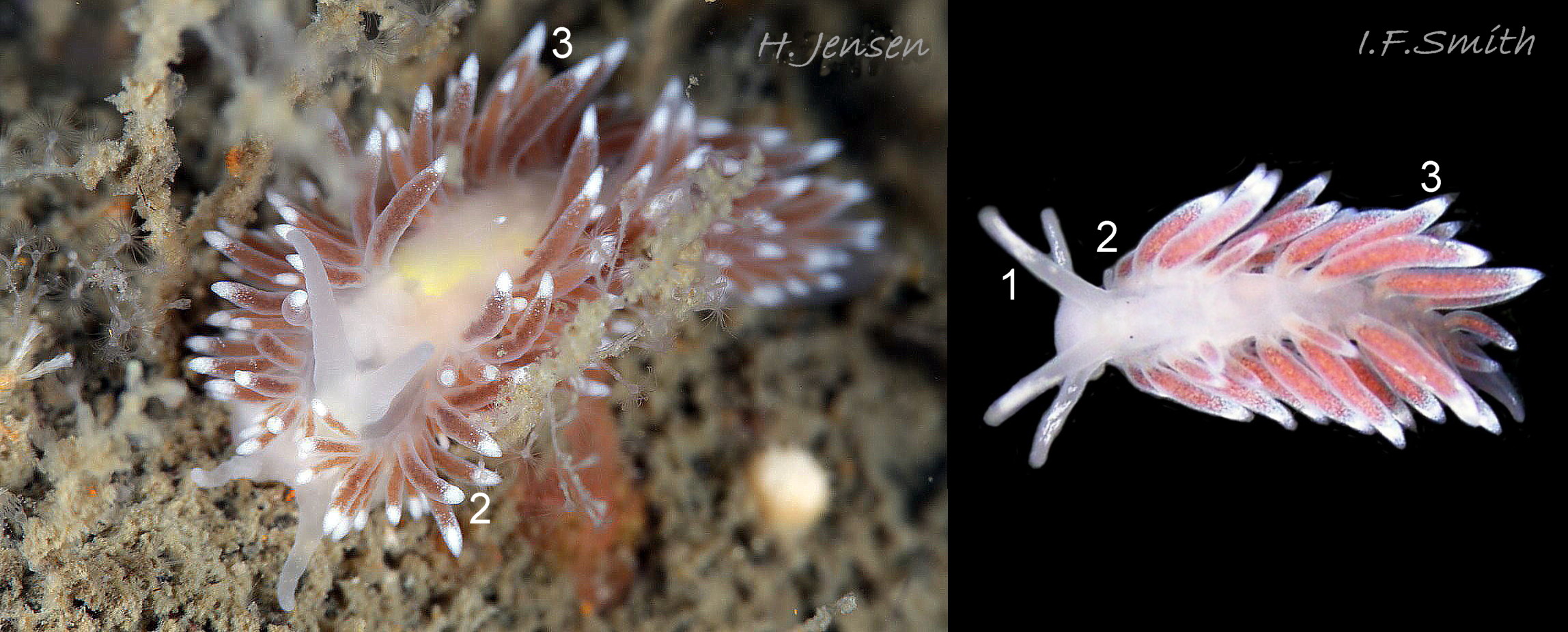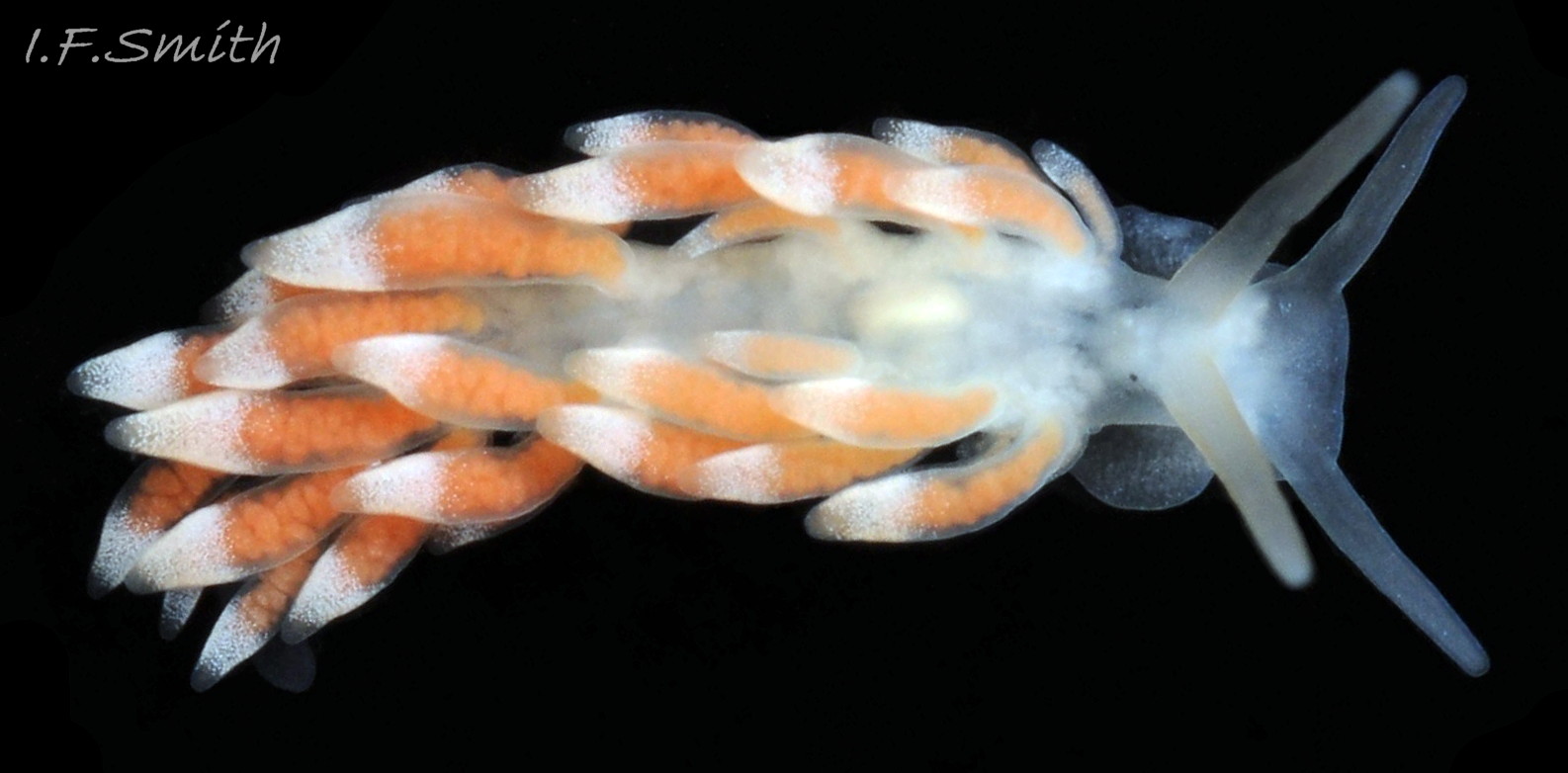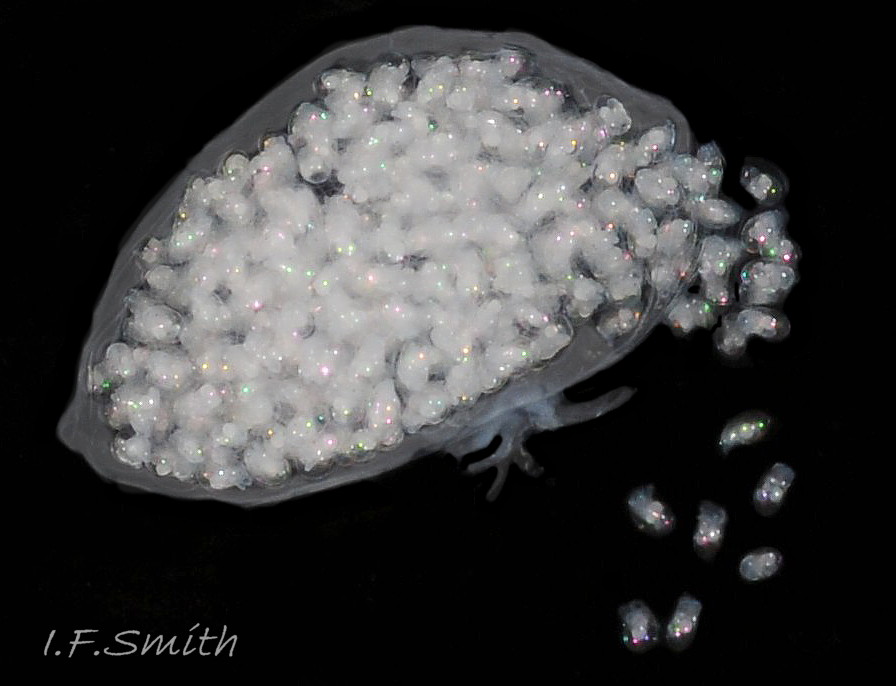Click image to enlarge with full caption. Main text below slider.
Catriona aurantia (Alder & Hancock,1842).
PDF available at www.researchgate.net/publication/363019731_Catriona_auran…
Current taxonomy: World Register of Marine Species www.marinespecies.org/aphia.php?p=taxdetails&id=156699
Synonyms: Eolis aurantia Alder & Hancock, 1842; Eolis aurantiaca Alder & Hancock, 1851; Cuthona aurantia (Alder & Hancock, 1842); Trinchesia aurantia (Alder & Hancock, 1842).
Schmekel & Portmann (1982) and Thompson & Brown (1984) incorrectly classed C. aurantia as a synonym of C. gymnota (Couthouy, 1838), which lives in the NW Atlantic from Cape Cod to Newfoundland. Other authors subsequently repeated this error. Molecular sequencing showed them to be distinct separate species (Korshunova et al., 2017).
GLOSSARY BELOW
Description
C. aurantia grows up to 22 mm long. The body is translucent white, sometimes delicately tinted orange 01 Catriona aurantia or rosy, with no surface markings. Sometimes, internal organs are visible, such as the oesophagus and circum-oesophageal nerve ring 02 Catriona aurantia .
The cerata are arranged in up to twelve transverse rows on each side of the body with up to seven cerata per row. They often conceal the sides and much of the dorsum of the body. They are translucent, revealing coral pink, orange brown, olive brown 03 Catriona aurantia or maroon brown 01 Catriona aurantia internal granular digestive glands. When well fed, the cerata are robust and widest in the upper half, but are thinner and more linear when unfed for a time 04 Catriona aurantia . The distal third of each ceras is capped with a large cone of dense, powdery, white pigment which is often extensively stained orange apically 03 Catriona aurantia . The small, extreme tip may be translucent white, but little can be seen of the cnidosac.
The smooth translucent rhinophores are tinted orange-brown 05 Catriona aurantia and have no surface pigment. A small, internal, black eye, resting on the circum-oesophageal nerve ring, can often be seen at the posterior base of each rhinophore 05 Catriona aurantia & 06 Cuthona aurantia .
The head has translucent white oral tentacles with no surface pigment 01 Catriona aurantia. Ventrally, it consists mainly of the large outer cleft lips of the mouth 07 Catriona aurantia .
The foot is widest at the anterior where it has rounded propodial swellings, but not propodial tentacles. Apart from a waist behind the anterior, it tapers steadily to a narrow posterior point when fully extended 08 Catriona aurantia
. White spheroid ovotestes may be visible through the translucent white sole, and the hermaphrodite genital opening is below the first row of cerata on the right 07 Catriona aurantia .
Key identification features
1) Translucent, orange-brown rhinophores with no opaque white pigment 05 Catriona aurantia .
2) Cerata always to posterior of rhinophores.
3) Large cone of powdery, white pigment, with orange staining covers distal part of cerata 09 Catriona aurantia .
4) Not associated with Hydractina echinata.
Similar species
Cuthona nana (Alder & Hancock, 1842) 10 Catriona aurantia.
1) Translucent, white rhinophores often with opaque white pigment marks.
2) Cerata more numerous than on Catriona aurantia and extend forwards of rhinophores on adults but not on juveniles.
3) Dense powdery pigment cap on cerata less extensive than on C. aurantia.
4) Usually on or near Hydractina echinata; often on shell of Hermit crab.
Habits and ecology
Catriona aurantia occurs at LWST on rocky shores and in shallow coastal waters where strong currents favour its hydroid prey, Tubularia spp. As it is usually at the base of the hydroid it is suspected to feed by penetrating the stems in preference to the polyps (Picton & Morrow, 2016). Like other nudibranchs, it is a simultaneous hermaphrodite. The spawn mass is a colourless, transparent kidney shape, which is placed at the base of Tubularia. It is attached by a broad stem on one side of the mass. Before release, moving hatched white veliger larvae are visible within case 11 Catriona aurantia . The transparent larval shell is reflective, usually with two mobile bright highlights which can iridesce green. After release from the case, the veliger larvae live in the plankton for up to ten days before transforming into the adult form. Breeding is in most months, and there are several generations each year (Miller, 1962).
Distribution and status
C. aurantia is recorded from northern Norway to Bretagne on the GBIF map www.gbif.org/species/2292304 (accessed August 2022) and is described and well illustrated from Galicia in Trigo et al. (2018, as C. gymnota). Schmekel and Portmann (1982) describe it (as C. gymnota) from the western Mediterranean but their image and description have deviations which put it in doubt; it resembles un-named Trinchesia sp. 2 in Prkić et al. (2018). There is no mention of it in Calado & Silva (2012) for Algarve, Portugal, or Prkić et al (2018) for Croatia. So it appears to be scarce in, or absent from, southern Iberia and the Mediterranean. It is widespread all round Britain and Ireland on hard substrate sea beds, and occasionally on rocky shores, where Tubularia occurs. NBN UK map species.nbnatlas.org/species/NHMSYS0021184935
Acknowledgements
For use of images, I thank Jim Anderson and Heine Jensen. For information and advice, I thank Jakov Prkić.
References and links
Alder, J. & Hancock, A. 1845-1855. A monograph of the British nudibranchiate mollusca. London, Ray Society. Family 3 Plate 27 www.biodiversitylibrary.org/item/131598#page/394/mode/1up
Calado, G. and Silva, J.P. (2012). Sea slugs of the Algarve. EdiçõesSubNauta
Korshunova, T., Martynov, A. and Picton, B. (2017). Ontogeny as an important part of integrative taxonomy in tergipedid aeolidaceans (Gastropoda: Nudibranchia) with a description of a new genus and species from the Barents Sea. Zootaxa. 4324(1): 1. www.biotaxa.org/Zootaxa/article/view/zootaxa.4324.1.1
Miller, M. C. 1962. Annual Cycles of Some Manx Nudibranchs, with a Discussion of the Problem of Migration. J. anim. Ecol. 31: 545–569.
Picton, B.E. & Morrow, C.C. 2016. Catriona aurantia (Alder & Hancock, 1842). [In] Encyclopedia of Marine Life of Britain and Ireland.
www.habitas.org.uk/marinelife/species.asp?item=W14780 Accessed August 2022.
Prkić, J., Petani, A., Iglić, Đ. and Lanča, L. 2018. Opisthobranchs of the Adriatic Sea. Photographic atlas and list of Croatian Species. Croatia.
Schmekel, L. & Portmann, A. 1982. Opisthobranchia des Mittelmeeres, Nudibranchia und Saccoglossa. Berlin, Springer.
Thompson, T.E. & Brown, G.H. 1984. Biology of opisthobranch molluscs 2. London, Ray Society.
Trigo, J.E.; Diaz Agras, G.J.; Garcia Alvarez, O.L.; Guerra, A.; Moreira, J.; Pérez, J.; Rolán, E.; Troncoso, J.S,; Urgorri, V.. 2018. Guia de los Moluscos Marinos de Galicia. Servicio de Publicacións da Universidade de Vigo.
Glossary
cerata = (sing. ceras) lobes on dorsum of aeolids and some other seaslugs.
circum-oesophageal nerve ring = ganglia-bearing nerve cord (the ‘brain’) which encircles the oesophagus in gastropods.
cnidocytes = explosive stinging cells of Cnidaria. en.wikipedia.org/wiki/Cnidocyte
cnidosac = storage capsule at tips of cerata of Aeolidiidae for ingested unexploded cnidocytes.
digestive gland = organ in gastropods which acts like liver and pancreas in mammals to absorb food.
distal = away from centre of body or from point of attachment.
ganglia = (sing. ganglion) knots containing sensory cell bodies on a nerve cord, which conducts impulses to innervate organs of the body.
LWST = low water spring tide; two periods of a few days each month when tide falls lowest.
oesophagus = tube from mouth to stomach.
ovotestis = (pl. ovotestes) hermaphrodite organ serving as both ovary and testis.
propodial tentacles = tentacular, lateral extensions on anterior of the foot.
propodium = anterior portion of gastropod foot. (adj. propodial).
rhinophores = chemo-receptor tentacles on top of head of nudibranch.
veliger = shelled larva of marine gastropod or bivalve mollusc which moves by action of cilia on a velum (bilobed flap). Stage may be passed in plankton or within liquid-filled egg-capsule.
